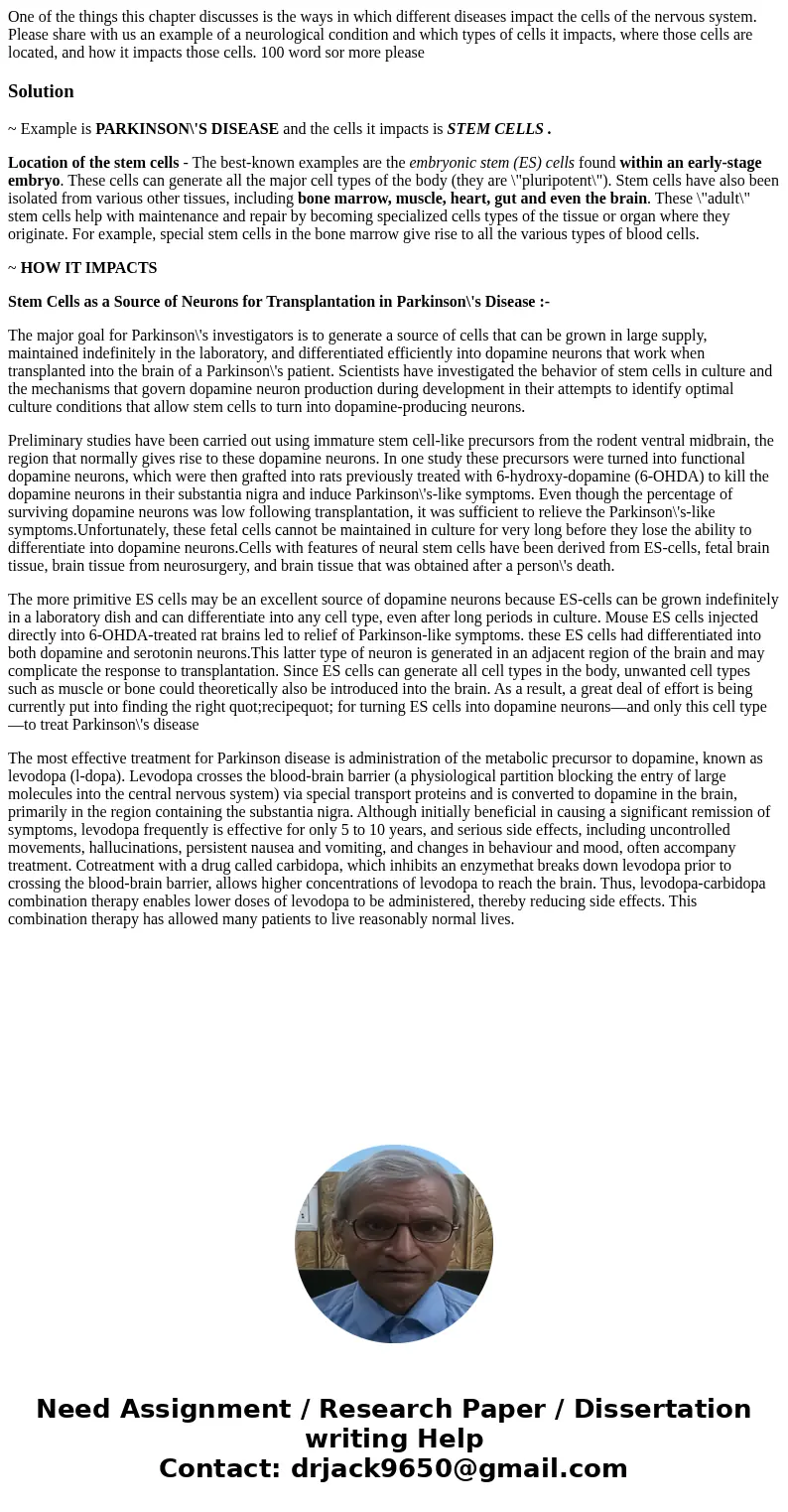One of the things this chapter discusses is the ways in whic
One of the things this chapter discusses is the ways in which different diseases impact the cells of the nervous system. Please share with us an example of a neurological condition and which types of cells it impacts, where those cells are located, and how it impacts those cells. 100 word sor more please
Solution
~ Example is PARKINSON\'S DISEASE and the cells it impacts is STEM CELLS .
Location of the stem cells - The best-known examples are the embryonic stem (ES) cells found within an early-stage embryo. These cells can generate all the major cell types of the body (they are \"pluripotent\"). Stem cells have also been isolated from various other tissues, including bone marrow, muscle, heart, gut and even the brain. These \"adult\" stem cells help with maintenance and repair by becoming specialized cells types of the tissue or organ where they originate. For example, special stem cells in the bone marrow give rise to all the various types of blood cells.
~ HOW IT IMPACTS
Stem Cells as a Source of Neurons for Transplantation in Parkinson\'s Disease :-
The major goal for Parkinson\'s investigators is to generate a source of cells that can be grown in large supply, maintained indefinitely in the laboratory, and differentiated efficiently into dopamine neurons that work when transplanted into the brain of a Parkinson\'s patient. Scientists have investigated the behavior of stem cells in culture and the mechanisms that govern dopamine neuron production during development in their attempts to identify optimal culture conditions that allow stem cells to turn into dopamine-producing neurons.
Preliminary studies have been carried out using immature stem cell-like precursors from the rodent ventral midbrain, the region that normally gives rise to these dopamine neurons. In one study these precursors were turned into functional dopamine neurons, which were then grafted into rats previously treated with 6-hydroxy-dopamine (6-OHDA) to kill the dopamine neurons in their substantia nigra and induce Parkinson\'s-like symptoms. Even though the percentage of surviving dopamine neurons was low following transplantation, it was sufficient to relieve the Parkinson\'s-like symptoms.Unfortunately, these fetal cells cannot be maintained in culture for very long before they lose the ability to differentiate into dopamine neurons.Cells with features of neural stem cells have been derived from ES-cells, fetal brain tissue, brain tissue from neurosurgery, and brain tissue that was obtained after a person\'s death.
The more primitive ES cells may be an excellent source of dopamine neurons because ES-cells can be grown indefinitely in a laboratory dish and can differentiate into any cell type, even after long periods in culture. Mouse ES cells injected directly into 6-OHDA-treated rat brains led to relief of Parkinson-like symptoms. these ES cells had differentiated into both dopamine and serotonin neurons.This latter type of neuron is generated in an adjacent region of the brain and may complicate the response to transplantation. Since ES cells can generate all cell types in the body, unwanted cell types such as muscle or bone could theoretically also be introduced into the brain. As a result, a great deal of effort is being currently put into finding the right quot;recipequot; for turning ES cells into dopamine neurons—and only this cell type—to treat Parkinson\'s disease
The most effective treatment for Parkinson disease is administration of the metabolic precursor to dopamine, known as levodopa (l-dopa). Levodopa crosses the blood-brain barrier (a physiological partition blocking the entry of large molecules into the central nervous system) via special transport proteins and is converted to dopamine in the brain, primarily in the region containing the substantia nigra. Although initially beneficial in causing a significant remission of symptoms, levodopa frequently is effective for only 5 to 10 years, and serious side effects, including uncontrolled movements, hallucinations, persistent nausea and vomiting, and changes in behaviour and mood, often accompany treatment. Cotreatment with a drug called carbidopa, which inhibits an enzymethat breaks down levodopa prior to crossing the blood-brain barrier, allows higher concentrations of levodopa to reach the brain. Thus, levodopa-carbidopa combination therapy enables lower doses of levodopa to be administered, thereby reducing side effects. This combination therapy has allowed many patients to live reasonably normal lives.

 Homework Sourse
Homework Sourse